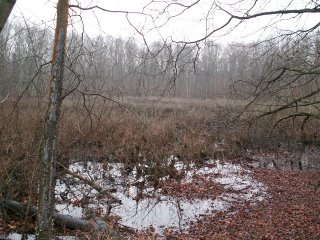New Years Eve is not exactly the right time of year, but late winter and early spring are, when rainy nights bring out lots of ambystomid salamanders such as spotted salamanders (Ambystoma maculatum) and tiger salamanders (Ambystoma tigrinum) for their mass mating sessions (I want to call them orgies, but that doesn’t sound scientific enough). I have never found either species, so I’m eager to try. This, then, was a scouting mission.
I should do this more often. I got a little lost yesterday as I always do on my first time out to a herping spot, but since being lost did not eat into any productive herping time, it was time well spent. Next time I go out, when I’m actually hoping to find something, I should know my way around a little better.
Here are a some pictures of the bays. The last one I took pictures of was on the large side – I’m not sure if it was a Delmarva bay or a normal pond.



For those who are interested in geology, Delmarva bays (http://www.dnr.state.md.us/naturalresource/spring2001/delmarvabays.html) and Carolina bays (they’re the same thing, just in different sections of the coastal plain) are enigmatic little ponds. They are several millennia old, and no one is sure exactly how they formed. Most have been destroyed for agriculture or development. They had more recently been covered by federal wetland protection laws, but due to a recent Supreme Court decision that takes the Army Corps of Engineers out of the business of protecting wetlands that are not connected to navigable bodies of water, they are again at risk (http://www.uga.edu/srel/Reprint/2704.htm).